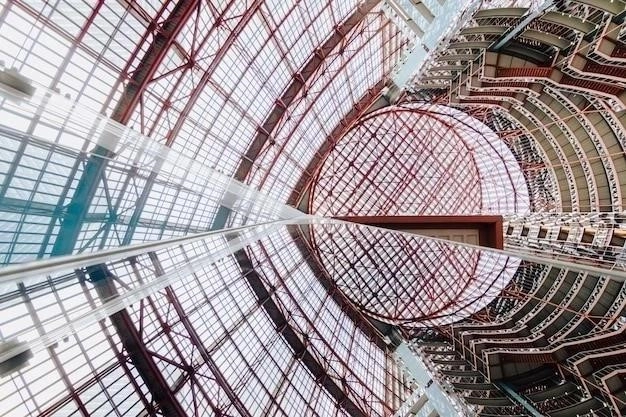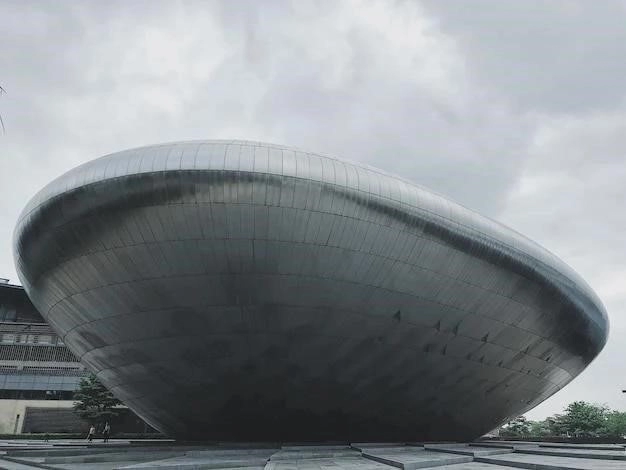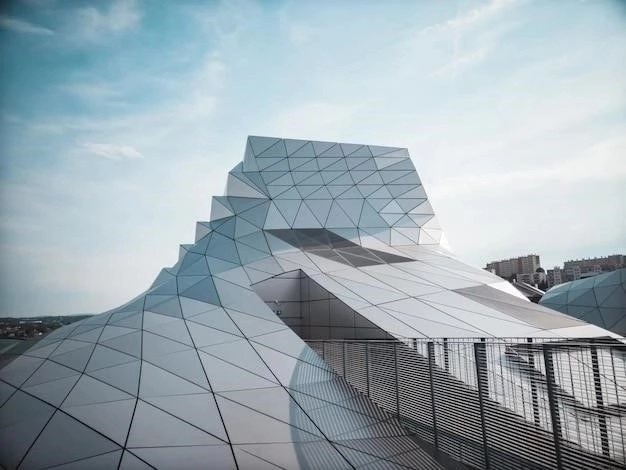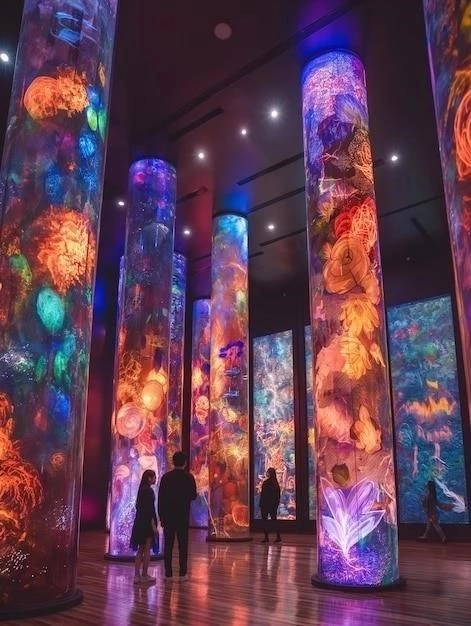Frank Lloyd Wright’s Vision
Frank Lloyd Wright envisioned a “temple of spirit” for Solomon R. Guggenheim’s collection of non-objective art. He sought to overturn conventional museum design, where hierarchies of space often dictate a rigid progression. Instead, Wright conceived a unified, flowing space where art and architecture would complement each other. This vision was realized in a spiral ramp that gently guides visitors upward, mimicking a natural ascent, while the open rotunda bathes the space in natural light.
Organic Architecture: Blending with Nature
The Guggenheim Museum stands as a powerful testament to Frank Lloyd Wright’s philosophy of organic architecture, a design approach that emphasizes harmony between human habitation and the natural world. Wright believed that buildings should exist in seamless integration with their surroundings, reflecting and celebrating the forms, materials, and principles found in nature.
This principle is evident in the Guggenheim’s iconic spiral form, inspired by the nautilus shell, a symbol of growth and evolution found in the natural world. The building’s curving lines and lack of sharp corners echo the organic shapes of nature, creating a sense of fluid movement that stands in stark contrast to the rigid grid system of Manhattan.
Beyond its form, the Guggenheim’s use of materials further reinforces its connection to nature. The building’s exterior is clad in white concrete, a material that, while man-made, evokes the raw, elemental beauty of natural stone. The large windows, strategically placed throughout the spiral, flood the interior with natural light, blurring the boundaries between the built environment and the world outside. This interplay of light and shadow mimics the effects of sunlight filtering through a forest canopy, further emphasizing the building’s organic nature.
In essence, the Guggenheim Museum transcends its function as a mere repository for art, becoming a living embodiment of Wright’s belief that architecture should be a celebration of nature’s inherent beauty and a testament to the harmonious relationship that can exist between humanity and the natural world.
The Spiral Ramp: A Revolutionary Design
At the heart of the Guggenheim Museum’s brilliance lies its revolutionary spiral ramp, a design element that fundamentally redefined the museum-going experience. This continuous, gently sloping incline, rising seamlessly from the ground floor to the skylight above, serves as both a circulatory spine and an exhibition space, blurring the lines between movement and observation.
Wright’s spiral ramp stands in stark contrast to the traditional model of museums as a series of interconnected rooms and floors, a format that often dictates a predetermined route through the collection. Instead, the Guggenheim’s ramp allows visitors to chart their own course, ascending gradually as they engage with the art at their own pace. This sense of individual exploration, enhanced by the ramp’s widening circumference, fosters a more intimate and contemplative encounter with the artwork.
Moreover, the spiral ramp’s design fosters a unique spatial dialogue between the art, the viewer, and the architecture. As visitors ascend, they are afforded ever-changing perspectives of the artwork, encouraging them to view the pieces from multiple vantage points. Simultaneously, the ramp offers captivating glimpses of the museum’s iconic rotunda, creating a dynamic interplay between light, space, and form that elevates the museum-going experience into a truly multi-sensory journey.
The Guggenheim’s spiral ramp, far from being a mere architectural flourish, represents a radical departure from convention, transforming the museum from a static repository of art into a dynamic space that actively engages the visitor in a continuous, unfolding dialogue with art and architecture.
The Rotunda Skylight: Illuminating the Space
Crowning Frank Lloyd Wright’s iconic spiral design for the Guggenheim Museum is the magnificent rotunda skylight, a masterpiece of engineering and a testament to the architect’s profound understanding of natural light. This expansive glass dome, composed of a series of interconnected triangular panes, serves as a beacon of natural illumination, bathing the museum’s interior in an ever-changing tapestry of light and shadow.
Wright’s ingenious design transcends the purely functional aspect of illumination, elevating natural light into an integral element of the museum’s architectural vocabulary. The skylight’s intricate geometric pattern, inspired by the radial symmetry of a spider web, casts a delicate network of shadows across the spiral ramp below, creating a dynamic interplay of light and form that animates the museum’s interior throughout the day.
Moreover, the rotunda skylight fosters a profound connection between the museum’s interior and the external environment. As sunlight filters through the glass panes, it washes over the curved walls, illuminating the artwork in a soft, diffused glow that accentuates the nuances of color and texture. This harmonious fusion of art, architecture, and natural light transforms the museum into a sanctuary of contemplation, inviting visitors to experience the collection in a truly unique and evocative atmosphere.
The Guggenheim’s rotunda skylight stands as a testament to Wright’s belief that architecture should not merely shelter us from the elements but should actively engage with the natural world, harnessing its beauty and power to elevate the human spirit.
Influences on Wright’s Design
Frank Lloyd Wright’s design for the Guggenheim Museum, while undeniably innovative, reflects a synthesis of diverse influences that shaped his architectural philosophy throughout his career. From ancient structures to Eastern aesthetics and the burgeoning principles of modernism, Wright masterfully wove together a tapestry of inspiration to create a building that was both timeless and groundbreaking.
One of the most striking influences on the Guggenheim’s design is the ancient Mesopotamian ziggurat, a terraced temple tower that ascended in a series of stepped levels towards the heavens. Wright reinterpreted this ancient form, inverting the ziggurat’s pyramidal structure into a continuous, upward-spiraling ramp that invited visitors on an ascending journey of artistic discovery.
Wright’s fascination with Japanese art and architecture is also evident in the Guggenheim’s design. The building’s emphasis on harmony with nature, its use of organic forms, and its seamless integration of interior and exterior spaces resonate with the principles of traditional Japanese aesthetics. The Guggenheim’s flowing spaces and carefully modulated light evoke the serene atmosphere of a Japanese garden, where architecture serves to enhance, rather than dominate, the natural world.
Furthermore, Wright’s design embraced the burgeoning principles of modernism, particularly its emphasis on functionality, innovation, and the expressive potential of new materials. The Guggenheim’s use of reinforced concrete, a material celebrated for its strength and plasticity, allowed Wright to create sweeping curves and cantilevered forms that would have been impossible with traditional building methods. This embrace of modern materials and construction techniques allowed Wright to push the boundaries of architectural possibility, creating a building that was both aesthetically daring and structurally innovative.

The Guggenheim’s Impact on Architecture
The Guggenheim Museum’s impact on architecture extends far beyond its iconic presence on Fifth Avenue. Completed in 1959, towards the end of Frank Lloyd Wright’s illustrious career, the building served as both a culmination of his architectural principles and a catalyst for future generations of architects, inspiring a wave of experimentation and innovation in museum design and beyond.
Wright’s revolutionary spiral ramp, a defining feature of the Guggenheim, challenged the conventional notion of the museum as a series of discrete, static galleries. This dynamic, flowing space, designed to guide visitors on an ascending journey through the art collection, broke down barriers between circulation and exhibition, paving the way for more immersive and experiential museum designs.
Moreover, the Guggenheim’s bold, sculptural form, a stark departure from the rectilinear structures that dominated mid-20th-century architecture, ushered in a new era of architectural expressionism. The building’s organic curves, inspired by nature’s forms, and its innovative use of reinforced concrete demonstrated the expressive possibilities of this versatile material, encouraging architects to explore beyond the limitations of traditional building methods.
The Guggenheim’s influence can be seen in countless museums, cultural centers, and public buildings around the world that have embraced its spirit of innovation, its celebration of natural light, and its commitment to creating a harmonious relationship between art, architecture, and the visitor. From the swirling forms of the Sydney Opera House to the light-filled atrium of the British Museum’s Great Court, the Guggenheim’s legacy continues to inspire architects to push the boundaries of design and to create spaces that elevate the human spirit.
The Museum as a Cultural Icon
Transcending its role as a repository for art, the Guggenheim Museum has secured its place as a global cultural icon, its distinctive silhouette instantly recognizable and synonymous with New York City’s vibrant artistic landscape. The building’s unconventional design, initially met with mixed reviews, has become a symbol of architectural innovation and a testament to the enduring power of Frank Lloyd Wright’s vision.
The Guggenheim’s iconic status is further amplified by its frequent appearances in popular culture, cementing its place in the collective imagination. From Hollywood films like “Men in Black” and “When in Rome” to countless television shows, books, and works of art, the Guggenheim has become a visual shorthand for sophistication, modernity, and the transformative power of art.
Moreover, the museum’s distinctive image has been widely appropriated for commercial purposes, appearing on everything from postcards and posters to coffee mugs and t-shirts, transforming it into a globally recognized brand. This widespread recognition, while at times bordering on commodification, speaks to the building’s enduring appeal and its ability to transcend geographical boundaries and cultural differences.
The Guggenheim’s transformation into a cultural icon underscores the power of architecture to capture the imagination and to embody the spirit of a place and time. Its enduring presence in popular culture serves as a constant reminder of its architectural significance and its ability to inspire awe and wonder in those who experience its unique blend of art, architecture, and human aspiration.

Criticisms and Controversies
Despite its status as an architectural icon and a beloved cultural landmark, the Guggenheim Museum has not been without its share of criticisms and controversies, sparking debates that continue to this day. These critiques, often voiced even during the building’s construction, highlight the inherent tensions between innovative architectural visions and the practical demands of exhibiting art.
One of the most persistent criticisms leveled at the Guggenheim concerns the functionality of its exhibition spaces. Critics argue that the sloping walls and continuous spiral ramp, while visually stunning, pose challenges for displaying certain types of artwork. The lack of traditional, flat wall surfaces can make it difficult to properly showcase large-scale paintings or sculptures, forcing curators to devise unconventional and sometimes awkward installation solutions.
Furthermore, some argue that the building’s powerful architectural presence can overshadow the art it houses. The Guggenheim’s dramatic curves, soaring spaces, and interplay of light and shadow can create a captivating sensory experience that threatens to distract from the contemplative appreciation of individual artworks. The museum’s design, while undoubtedly innovative, has been accused of prioritizing architectural spectacle over the art itself.
Despite these criticisms, the Guggenheim remains a powerful testament to the enduring dialogue between art and architecture. Its unconventional design, while not without its challenges, continues to spark debate, challenge conventions, and inspire innovative approaches to the museum-going experience.

The Guggenheim Today: A Legacy of Innovation
More than six decades after its completion, the Guggenheim Museum stands not as a static monument to a bygone era, but as a vibrant testament to the enduring power of architectural innovation. Its iconic spiral design, once a radical departure from convention, continues to captivate and inspire, serving as a beacon of creativity for both the art world and the field of architecture.
The Guggenheim today remains a dynamic institution, constantly evolving to meet the demands of a changing artistic landscape. Its exhibition program, renowned for its cutting-edge contemporary art, performance art, and architectural installations, embraces experimentation and challenges traditional notions of what a museum can be. This commitment to innovation ensures that the Guggenheim remains at the forefront of contemporary culture, pushing boundaries and sparking conversations about art and its role in society.
Beyond its walls, the Guggenheim has expanded its reach globally, establishing a network of affiliated museums and initiatives that embody its commitment to artistic excellence and cross-cultural dialogue. From the Peggy Guggenheim Collection in Venice to the Guggenheim Museum Bilbao, designed by Frank Gehry, these institutions carry forward Wright’s legacy of architectural innovation and his belief in the transformative power of art.
The Guggenheim Museum today stands as a testament to the enduring power of a bold vision. Its unwavering commitment to innovation, its embrace of contemporary artistic expression, and its global reach ensure that it will continue to inspire and provoke for generations to come.

Visiting the Guggenheim: An Unforgettable Experience
A visit to the Guggenheim Museum transcends the typical museum experience, becoming a journey of architectural discovery and artistic immersion. From the moment you approach its iconic white spiral on Fifth Avenue, you are transported to a world where art and architecture intertwine to create a truly unforgettable experience.
As you enter the museum’s grand rotunda, bathed in soft, natural light streaming through the expansive skylight, you are immediately struck by the building’s unique spatial flow. The gentle slope of the spiral ramp invites you to embark on an ascending journey, guiding you effortlessly through the museum’s collection at your own pace.
The ramp’s design encourages a dynamic interplay between movement and observation. As you ascend, you are treated to ever-changing perspectives of the artwork, allowing you to appreciate pieces from multiple vantage points and to discover unexpected connections between them. The play of light and shadow, cast by the skylight’s geometric patterns, creates a constantly shifting ambiance, enhancing the artwork’s visual impact and adding another layer of sensory richness to your experience.
Beyond its architectural marvels, the Guggenheim offers a rich and diverse collection of modern and contemporary art, from the early pioneers of abstract art to the most cutting-edge contemporary installations. Whether you are a seasoned art enthusiast or a curious newcomer, the Guggenheim’s captivating blend of art, architecture, and ambiance is sure to leave a lasting impression.










